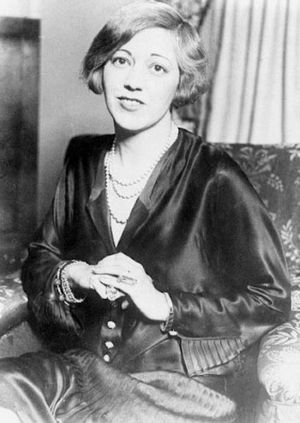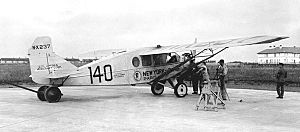Mabel Boll facts for kids
Mabel Boll (born December 1, 1893 – died April 11, 1949) was a famous American socialite. She was known as the "Queen of Diamonds" because of her love for expensive jewelry. In the 1920s, she became well-known for her involvement in early airplane flights. The newspapers often called her "Broadway’s most beautiful blonde."
Early Life and Fame
Mabel Boll was born in Rochester, New York. Her father, George, worked as a bartender. Despite later claiming to be from a wealthy family, this was not true. Mabel was known for her striking looks, with dark eyes and bright blonde hair. She started her career selling cigars in Rochester.
Mabel was also a skilled horse rider. In 1909, she married a businessman named Robert Scott. They had a son, Robert Scott II, in 1914.
Mabel earned her nickname, "The Queen of Diamonds," because she wore so much jewelry in public. Sometimes, she would wear over $400,000 worth of jewels. She was even photographed in a sweater made of gold and platinum!
In 1922, Mabel married Hernando Rocha, a wealthy coffee businessman from Colombia. He gave her over a million dollars in jewels. One special gift was a huge 46.57-carat emerald-cut diamond. It was named "The Mabel Boll" after her. After her death in 1949, this famous diamond became part of the Harry Winston collection.
Aviation Adventures
Dreaming of Transatlantic Flight
The year 1927 was exciting for aviation. Charles Lindbergh became a hero by flying non-stop from New York to Paris. This flight won him the Orteig Prize. Mabel Boll wanted to be famous too. She thought being the first woman to fly across the Atlantic Ocean would make headlines. While in Paris, France, she offered a large sum of money to any pilot who would fly her across the Atlantic.
Flying in the Columbia
The Columbia was an airplane that had just set a record by flying from New York to France. Its owner, Charles A. Levine, planned to fly it back to America. Mabel Boll tried to convince Levine to let her be a passenger. She even followed him to England by boat to talk him into it.
However, the pilot, Captain Walter G. R. Hinchliffe, refused to fly if Mabel was on board. Instead, Mabel flew to Rome and dropped a gift for Benito Mussolini's son. Later, she was invited to try an east-west flight from America. She traveled to New York in January 1928.
On March 5, 1928, Mabel Boll made history. She flew non-stop in the Columbia from New York City to Havana, Cuba. She sat on an improvised seat for the journey. This flight put her on the front page of the New York Times.
Mabel was known for being a difficult passenger. Once, she even injured a pilot with her alligator handbag! This happened when he landed too early because of bad weather.
The Race Across the Atlantic
In 1928, many people wanted to be the first to fly a woman across the Atlantic as a passenger. Charles Levine chose Mabel Boll, who was very flashy. On the other hand, Amelia Earhart was chosen by her sponsors, George Palmer Putnam and Amy Phipps Guest. Earhart was known for being calm and a skilled pilot.
On June 26, 1928, Mabel Boll was filmed leaving Roosevelt Field in the Columbia. She was later seen 1,100 miles away in Harbour Grace, Newfoundland. She was still a passenger in the Columbia, which was flown by Oliver Colin LeBoutillier and Arthur Argles. Mabel publicly announced her goal to be the first woman to fly across the Atlantic. Amelia Earhart and German pilot Thea Rasche were also in Newfoundland at the same time.
Newspapers focused on Mabel, calling her "The Diamond Queen of Broadway." Her flight preparations were very public. Meanwhile, Amelia Earhart's team was preparing their plane, the "Friendship," in secret. On June 17, the "Friendship" took off from Trepassey, Newfoundland, with Earhart on board. The Columbia crew was stuck on the ground for five days due to bad weather. When Mabel learned that Earhart had successfully flown across, she returned to America. She donated $500 to the Newfoundland airstrip to help with its development.
Mabel Boll wanted a new nickname: "The Queen of the Air." For her last serious attempt at a record, Levine bought a special long-range Junkers W 33 airplane. It cost $50,000 and had "Queen of the Air" written on its sides. They planned for pilot Bert Acosta to fly Mabel and Levine from Paris to New York. This plan later changed to a London to New York attempt.
However, the flying season was ending, and Levine had legal issues. The "Queen of the Air" plane was sent back to America. It was damaged and later sold to another pilot, William Rody. He renamed it and tried a transatlantic flight in 1931. The plane landed in the Atlantic Ocean, but its empty fuel tanks kept the crew afloat until they were rescued.
Mabel's last chance to be a transatlantic passenger was turned down by another airplane owner. By 1936, she announced that she was no longer obsessed with flying.
Later Life and Passing
Mabel Boll continued to appear in newspapers during the 1930s and 1940s. However, her fame slowly faded. In 1939, she left her home in Switzerland as World War II began in Europe.
Mabel Boll passed away on April 11, 1949, at the age of 55. She died from a stroke at the Manhattan State Hospital, which was a psychiatric hospital on Wards Island in New York City.




